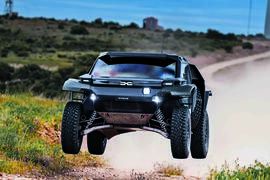 Romania's favourite car manufacturer is hoping to crack it first time out with star-studded line-up
Romania's favourite car manufacturer is hoping to crack it first time out with star-studded line-up
What a place to make your first mark in motorsport. Dacia, the Romanian budget car brand that has zero association with competition motoring, will plunge head first with a three-car entry into the epic, most gruelling event of them all.
The Dakar Rally will run for the sixth time in the deserts of Saudi Arabia (despite its name) across two weeks from 3 to 17 January, and what’s most remarkable is not just the inclusion of the Renault-owned car maker among the 340 entries in classes for cars, motorcycles and trucks: it actually (whisper it) has a genuine chance to win.
That’s because Dacia took the eminently sensible decision to partner with Prodrive for its first motorsport campaign. One of the world’s most respected competition specialists, Prodrive hasn’t yet won the Dakar but it sure knows a thing or two about the famous rally raid, through its previous Hunter T1+ programme, which culminated in a podium third for World Rally Championship legend Sébastien Loeb last January.
Loeb is back to helm one of the Dacias, along with his old Extreme E partner Cristina Gutiérrez and five-time Dakar winner Nasser Al-Attiyah. A decent line-up, to put it mildly.
So there’s hope, perhaps even optimism. But Prodrive’s team of grizzled engineers know better than to make rash predictions. To conquer the Dakar, its three all-new Dacia Sandriders must negotiate a prologue and 12 stages that include a so-called ‘chrono’ that lasts 48 hours (no, that’s not a typo) and another dubbed ‘marathon’ and emerge unscathed from the desert region known, all too accurately, as the Empty Quarter.
From the start in Bisha to the finish in Shubaytah, the total mileage is 4784, and 3168 of them are within the competitive stages. It’s beyond daunting.
But why is Dacia doing it? We travelled to to Prodrive’s Banbury base beside the M40 to find out.

The short answer is because it’s “cool”, according to Dacia UK brand director Luke Broad.
Also, in the wake of the brand’s repositioning as the rugged, outdoors choice for those on a budget, the epic rally meets Dacia’s new principle for “human adventure”.
“The ambition is to win,” says Broad. “But this is also an outdoor technical laboratory to develop innovations that will influence our road cars, and it’s an experiment with sustainable fuels.” To that end, the Sandrider runs on a synthetic brew supplied by Aramco. The Ultimate T1+-class machine is a bespoke design that, insists technical director Philip Dunabin, is a genuine Dacia. The company’s designers were involved in the concept and styling, a collaboration with Prodrive that, says Dunabin, worked smoothly.
The Sandrider is built around a rugged tubular steel chassis clad in carbonfibre bodywork, powered by a 3.0-litre Nissan V6 through a bespoke 4x4 transmission on all-terrain BF Goodrich tyres.
Looking around the car, the double spring-and-shock parallel arrangement at the rear stands out, and gives it a logical advantage. “With a two-damper system, if you lose one you’ve still got something to carry the car,” says Dunabin.
The spare wheels, tucked into large ducts behind either side of the cockpit, allow for quick release. The drivers and their navigators have been drilled on all manner of repairs by Prodrive, because on stage they’re on their own.
Team members aren’t allowed to physically help them. Nevertheless, support is always close at hand. The three Sandriders will be chased at intervals of around 40-50 minutes by T5 race trucks actually entered on to the event but run solely as technical back-up.
Inside the air-conditioned cabin, space is predictably tight. There’s a hydraulic handbrake and a robust mechanical gearlever. The navigators have two tablet screens to work from and the drivers have a small screen in their eyeline to indicate direction. Rally raiding isn’t like the WRC, with drivers listening to detailed pace notes, because, to coin a phrase, where they’re going they don’t need roads…

“The overall package is extremely compact and it’s probably that which gives us the most performance,” says Dunabin. “A lot of the weight is contained within the wheelbase. It’s the not so visible things that count: getting the centre of gravity down, keeping the weight between the wheels, which makes the car manageable.”
The Dakar isn’t just tough on drivers, but also on the whole team, who must be self-reliant. “The organisers provide bivouacs with food, showers and toilets. The rest is on us,” says chief technician Alan McGuinness.
We’re shown one-person tents, some of which are mounted on top of service trucks. They are more comfortable than they look, apparently – although drivers have their own motorhomes.
The quiet sense of optimism is born from a near-perfect start for the Sandrider. A design only conceived in the first half of 2023, revealed last spring and tested incessantly through the summer is already a winner.
The five-day Morocco Rally in October is a traditional Dakar warm-up, and Al-Attiyah and Loeb delivered a resounding one-two.
Dunabin looks on his Sandrider with obvious pride. “I’ll be more attached to it if we win the Dakar!” he says. “It’s a bit like doing endurance racing: if you win the Le Mans 24 Hours or Dakar, it’s a similar thing. There’s only one event that counts the most.”